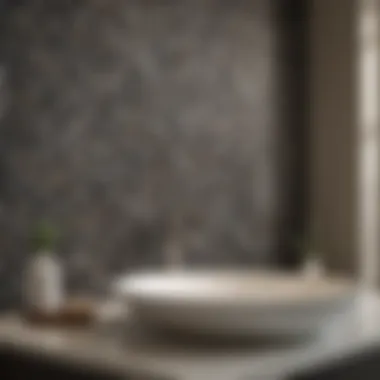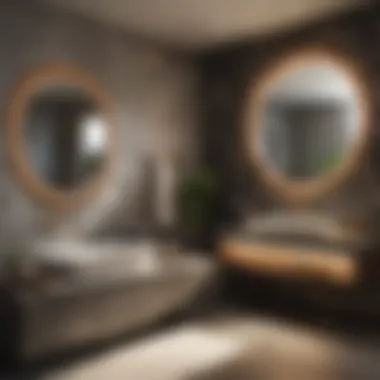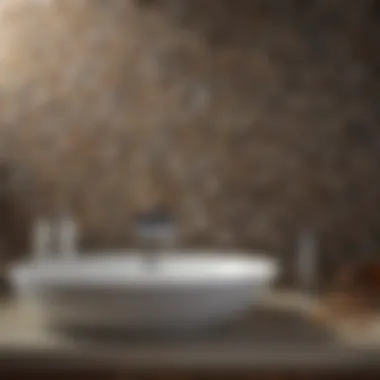Aesthetic and Functional Appeal of Pebble Backsplashes


Intro
The transformation of bathroom spaces has become a significant focus in contemporary interior design. Pebble backsplashes have emerged as a favored option, blending aesthetic charm with practical advantages. This article will explore the captivating world of pebble backsplashes and provide insightful information on how to integrate them into bathroom designs effectively.
Trending Styles
Modern Minimalism
In modern minimalist design, the preference is for simplicity and functionality. Pebble backsplashes can serve as a natural complement to clean lines and uncluttered spaces. A selection of light-colored pebbles can enhance the airy feel of a minimalist bathroom. The subtle textures of the stones provide a contrast to smooth surfaces, creating visual interest without overwhelming the eye. Homeowners should consider smooth pebbles in neutral hues for a quiet elegance.
Cozy Rustic
Rustic design embraces warmth and nature. Pebble backsplashes fit perfectly into this aesthetic, bringing an organic touch to bathroom spaces. Darker pebbles paired with reclaimed wood can evoke a sense of serenity. This style often uses natural materials that foster a welcoming environment, making the bathroom feel like a peaceful retreat. Homeowners can choose a mix of sizes and shapes in their pebbles, enhancing the earthy feel of the design.
Color Palettes
Calming Neutrals
Neutral tones are a safe choice for any bathroom. Pebble backsplashes in creams, beiges, or soft grays can evoke a soothing atmosphere. These colors are versatile and can be paired with various fixtures and furnishings. The enduring quality of neutral palettes ensures that the design remains timeless, appealing to numerous tastes.
Bold Accents
Pebble backsplashes need not shy away from vibrant colors. Homeowners can select pebbles in hues of deep blues, greens, or even rich reds to create a striking focal point. Bold accents can draw attention to particular areas in the bathroom, like above a vanity or a soaking tub. This approach allows for personalization and adds character to the space, making it uniquely yours.
"Integrating pebble backsplashes into a bathroom transforms not only the visual appeal but also the overall ambiance of the space." - Interior Design Expert
Finale
The incorporation of pebble backsplashes in bathroom design is more than a mere trend. It represents a balance of aesthetic beauty and functionality. Understanding the styles and color palettes can guide homeowners in creating a cohesive and inviting environment. As we advance in this article, we will explore installation techniques and maintenance requirements, equipping you with complete knowledge to make informed choices in your home.
Prologue to Pebble Backsplash
Pebble backsplashes have gained notable attention for their unique visual appeal and practical benefits in bathroom design. This article covers the essential elements of pebble backsplashes, from their aesthetic contributions to their functional properties. Understanding these aspects can greatly assist homeowners and designers when contemplating upgrades or renovations.
The use of pebbles in bathroom design reflects a connection to nature. They provide an earthy feel that can elevate any space. Choosing the right materials, colors, and designs can transform a simple bathroom into a serene retreat. Thus, the subject of pebble backsplashes is not just about style; it also encompasses versatility and durability.
Defining Pebble Backsplash
A pebble backsplash is a decorative wall feature typically made from small, smooth stones. These stones can be grouped together in various patterns or arrangements. Their natural shape and texture create a visually dynamic surface. Pebble backsplashes are often used in bathrooms, but they can also enhance kitchen spaces.
This type of backsplash can come in a mixture of colors, sizes, and types of stones. Some common materials include river rocks, sea pebbles, or even handmade ceramic pebbles. The choice of material heavily influences the overall vibe of the design.
Historical Context and Trends
The trend of using pebble backsplashes finds its roots in ancient design practices. Many cultures incorporated natural stones in their architectural features. In recent years, however, there has been a resurgence in using pebbles within modern interior designs. This shift can be attributed to a growing appreciation for organic materials and textures.
In modern bathroom design, pebbles are often combined with contemporary elements like glass, metal, or wood. This eclectic mix creates visual interest while maintaining a clean aesthetic. According to design experts, pebble backsplashes are in line with the sustainability movement, reflecting a desire for elements that connect indoor environments to the natural world.
Overall, the introduction of pebble backsplashes in bathroom designs reflects both aesthetic trends and practical needs. With the right information, homeowners can effectively integrate these features into their spaces.
Aesthetic Appeal of Pebbles
The aesthetic appeal of pebble backsplashes presents a significant dimension in bathroom design. These installations can easily transform an ordinary space into a sanctuary of beauty and relaxation. The natural look of pebbles brings warmth and character, evoking a connection with nature. This section will explore two main aspects of this appeal: the natural aesthetic and diverse color variations, along with the texture and depth that pebbles can add to a bathroom.
Natural Aesthetic and Color Variations
Pebble backsplashes offer a unique, organic aesthetic that enhances the visual interest in bathroom spaces. Each pebble is distinct, presenting variations in size, shape, and color. This randomness means homeowners can create patterns or arrangements that suit their personal style.
The color palette is vast, ranging from earthy tones like browns and greens to vibrant blues and whites. This flexibility in color allows for easy integration with various design themes. Whether you prefer a minimalist white bathroom or a pop of color against neutral tiles, pebbles can be adapted to fit these preferences.
Key Benefits:
- Diversity in Design: The different colors and textures of pebbles facilitate creativity in design.
- Connection to Nature: Natural materials create a calming atmosphere, adding a peaceful element to your bathroom.
- Timelessness: Pebble designs tend to be enduring, appealing across various styles and trends.
Texture and Depth in Bathroom Design
Beyond color, the texture of pebbles introduces a tactile element that can enhance the overall aesthetic. The surfaces of pebbles have a rounded and smooth quality, often providing a pleasant contrast to other finishes like tiles or metal fixtures. This tactile variance engages the senses, promoting a more inviting ambiance.
Incorporating pebble backsplashes can also create visual depth. The three-dimensional nature of pebbles can make a flat wall more dynamic. Shadows and light interplay on the stone surfaces can change as the day progresses, adding yet another layer to the design.


A well-executed pebble backsplash can serve both visual and functional purposes:
- Visual Depth: Rocks protruding slightly can create intriguing shadows.
- Tactile Experience: A smooth pebble surface can feel relaxing when touched.
- Focus Point: It can draw the eye, becoming the focal point of your bathroom.
"The interplay of natural aesthetics and texture not only enhances the beauty of a bathroom but also contributes to a cohesive design philosophy that prioritizes comfort and visual interest."
Functional Advantages of Pebble Backsplashes
When considering a pebble backsplash, many homeowners ponder its practical benefits in addition to its visual appeal. Understanding the functional advantages of pebble backsplashes is essential for making informed design choices. These unique features help blend aesthetic and efficient solutions, enabling homeowners to enhance their bathrooms both functionally and visually.
Water resistance and durability form the cornerstone of why pebble backsplashes are becoming increasingly popular in modern bathroom designs. Pebbles are naturally water-resistant, making them ideal for environments prone to moisture. This means that your backsplash will maintain its charm in the damp bathroom conditions without the fear of warping or degrading. Additionally, the durability of stones contrasts sharply with standard ceramics or tiles, which may chip or crack over time. This long-lasting feature reduces the need for frequent replacements, making it a smart investment for a bathroom renovation.
Water Resistance and Durability
Pebble backsplashes stand out in terms of water resistance. The porous nature of stones, when properly sealed, repels moisture effectively. This resistance is vital in a bathroom setting, where products used for cleaning and the everyday presence of water can otherwise contribute to structural damage or discoloration. By blocking moisture, pebble backsplashes help prevent the growth of mold and mildew, which can be detrimental both to aesthetics and health.
The durability of these natural stones is another appealing factor. Unlike traditional tile options, pebbles resist staining and can withstand scratches from daily use. Homeowners often underestimate the amount of wear and tear that walls endure, especially in high-traffic areas like bathrooms. Thus, pebble backsplashes provide a texture that is not only resilient but can handle everyday challenges, keeping them looking newer for longer.
"The combination of water resistance and durability makes pebble backsplashes a valuable option for any bathroom design."
Ease of Cleaning and Maintenance
One of the remarkable functional advantages is the ease of cleaning and maintenance. Pebble backsplashes require minimal upkeep compared to other materials. Unlike porous drywall or wood, which can absorb stains or odors, pebbles are inherently less prone to such issues when sealed correctly.
Routine cleaning can be as straightforward as wiping down the surface with a mild detergent and water. This efficiency saves time and effort, appealing to busy homeowners who might find themselves overwhelmed with cleaning tasks. It is recommended to avoid harsh chemicals that can damage the sealant over time.
To maintain their natural look and feel, a biannual inspection is advisable. Simply reapplying sealant preserves their waterproof quality and prevents any buildup of grime in between the pebbles. Thus, homeowners can enjoy the beauty of natural stone without the burden of constant maintenance chores.
Material Considerations for Pebble Backsplashes
When choosing a pebble backsplash for bathrooms, it's vital to consider various material elements. The type of pebbles you select will significantly impact not just the visual character of the space, but also its functionality. Understanding the different material possibilities can aid homeowners in making choices that best suit their style and practical needs.
Types of Pebble Materials
Pebble materials are varied, each offering unique characteristics. Commonly used pebbles include:
- River Stones: Smooth and rounded, river stones have a natural appearance. They come in assorted colors and sizes, enhancing the visual appeal of bathrooms.
- Polished Pebbles: These pebbles are smoothed and glimmer under light. The shine can add a lavish touch, making them perfect for elegant designs.
- Unglazed Ceramic Pebbles: These are often budget-friendly and can mimic natural pebbles. They are durable but may lack the authenticity desired in some settings.
- Glass Pebbles: These are lightweight and come in many colors. Glass reflects light beautifully, making bathrooms appear more vibrant.
Each type has advantages. For instance, river stones are excellent for a rustic look, while polished pebbles add luxury. Homeowners must assess which material aligns with their aesthetic and practical desires.
Comparative Analysis with Other Materials
Comparing pebble backsplashes to other materials is essential for informed decision-making. Common alternatives include tiles, glass, and natural stone. Here are some points to consider:
- Tiles vs. Pebbles: Tiles can provide uniformity and consistent colors. However, they lack the organic feel and texture that pebbles inherently possess. Tiles may also be more prone to chipping when compared to resilient pebble materials, especially in high-impact areas.
- Glass vs. Pebbles: While glass offers a sleek and modern appearance, pebbles add depth and warmth to a bathroom space. Glass can be more delicate, whereas pebbles withstand humid conditions better.
- Natural Stone vs. Pebbles: Natural stones like slate or granite deliver durability. However, they can be heavy and may require specialized installation. Pebbles are typically lighter and more versatile in application, making them easier to handle during installation.
"When it comes to bathroom design, the material choice can radically alter the space's character, influencing both aesthetics and practicality."
Homeowners should reflect on these comparisons, weighing the pros and cons to select a backsplash that not only beautifies their bathroom but also meets their lifestyle needs.
Installation Process of Pebble Backsplashes
The installation process of pebble backsplashes is a pivotal aspect of this article, as it directly impacts the overall aesthetic and functional performance of the bathroom. Proper installation ensures durability and maintains the visual integrity of the design. It is essential to consider each step meticulously, as even minor errors can result in significant issues later. Understanding this process can empower homeowners and remodelers, enabling them to achieve a polished finish while avoiding common pitfalls.
Preparation Steps for Installation
Preparation is key in ensuring a smooth installation experience. Here are some crucial steps to take before you begin:
- Assess the Surface: Before installation, check if the wall is clean, dry, and smooth. Any irregularities may cause the pebbles to adhere improperly.
- Gather Materials: Confirm you have enough pebble tiles for the area, along with grout and adhesive that is suitable for wet environments.
- Plan Layout: Designing a layout can prevent mistakes during installation. It’s advisable to dry-fit a couple of rows to visualize the final appearance and adjust spacing as necessary.
- Ensure Source of Light: Good lighting helps to identify any issues during installation. Make sure you can see clearly throughout the process.
Tools Required for Installation
Having the right tools at hand can streamline the installation process. Here’s a checklist of the essential tools:
- Tile Cutter: For shaping tiles to fit around fixtures and corners.
- Level: Ensures your backspalsh is even, preventing water pooling.
- Trowel: A notched trowel works best for spreading adhesive evenly.
- Float: Used for applying grout after the tiles are placed.
- Sponge and Bucket: For cleaning excess grout during and after the application.
Step-by-Step Installation Guide
Follow these steps for a successful installation of your pebble backsplash:


- Prepare the Wall: Ensure the surface is ready, free of dust, and dry. If necessary, apply a primer to enhance adhesion.
- Apply Adhesive: Using a notched trowel, spread adhesive on a section of the wall, starting from the bottom and working upwards. Only apply enough for a few rows to avoid it drying out before you place the tiles.
- Place the Pebble Tiles: Press the pebble tiles into the adhesive firmly. Make sure you follow the planned layout. Use spacers to maintain gaps for grout, if desired.
- Cut Tiles as Needed: Use a tile cutter to shape tiles for edges and corners. Ensuring a good fit is important for the overall finish.
- Allow Adhesive to Set: Follow manufacturer instructions on how long the adhesive needs to cure before grouting.
- Grouting: After the adhesive has set, mix the grout and apply it over the stones using a float, pushing it into the gaps between tiles.
- Clean Excess Grout: Use a damp sponge to wipe away excess grout from the surface of the tiles. Be careful not to remove the grout from between the stones.
- Sealing: Once the grout is fully cured, apply a sealer to protect your investment, especially in a moisture-prone area like a bathroom.
The installation of pebble backsplashes can be rewarding with the right approach. Each step counts towards a finished product that combines functionality with the aesthetics of natural stone.
Design Combinations and Style Integrations
The allure of a pebble backsplash extends beyond its individual beauty. It thrives in the context of cohesive design combinations and thoughtful style integrations. When selecting a pebble backsplash, one must consider how it interacts with other design elements in the bathroom. Achieving a harmonious blend elevates the overall aesthetic and functionality of the space. This section will delve into essential aspects of integrating pebble backsplashes into various bathroom themes.
Combining Pebbles with Various Design Themes
Pebble backsplashes are versatile and can complement a myriad of design themes. Whether your preference leans towards modern, rustic, coastal, or eclectic styles, pebbles can enhance the visual narrative of your bathroom. For modern spaces, smooth, monochromatic pebbles in neutral tones can maintain a sleek look. In contrast, rustic themes benefit from a more varied stone selection, emphasizing natural textures and colors.
Coastal designs often employ lighter colored pebbles with subtle blues or greens. These stones mimic the beach's natural environment, fostering a serene atmosphere. Eclectic designs allow for more playfulness; thus, colorful and mis-matched pebbles can create a vibrant, whimsical backdrop.
Choosing the right pebble backsplash can also unify the overall theme. For example, incorporating pebble materials that reflect flooring or countertops can help tie various elements together in one coherent look.
Color Schemes and Accent Choices
Color schemes play a vital role when integrating pebble backsplashes. The choice of pebble color directly impacts the mood and style of the bathroom. Natural stone colors range from earthy browns and greens to vibrant whites and grays. Homeowners should align their pebble selection with the bathroom's primary color scheme. For instance, if the bathroom features white walls and dark wooden elements, a warm beige pebble backsplash can offer balance.
Accent choices can further enhance the pebble’s visual presence. Using neutral tiles or painted walls as a backdrop allows the pebbles to become focal points. Additionally, incorporating metallic fixtures or accessories against the earthy tones of pebbles elevates the aesthetic. This contrast can introduce sophistication while maintaining the organic feel that pebbles provide.
Key Insight: Carefully selected color schemes and accents can transform a seemingly simple pebble backsplash into an eye-catching feature that enhances your entire bathroom design.
Conclusively, when homeowners approach the integration of pebble backsplashes, an awareness of design combinations and effective color schemes is fundamental. Thoughtful consideration ensures that each element coexists in harmony, creating a bathing space that is both functional and appealing.
Common Mistakes to Avoid
Incorporating pebble backsplashes in bathroom design can greatly enhance the space. However, certain common mistakes can detract from the intended aesthetic and functionality. Recognizing these pitfalls is essential for homeowners and designers alike. Avoiding such errors ensures the investment made is both practical and pleasing.
Incorrect Material Selection
Choosing the right materials for pebble backsplashes is crucial. Many homeowners may not realize that pebble materials vary significantly in quality and appearance. Using cheap or unsuitable materials can lead to a backsplash that does not perform well over time.
When selecting pebbles, consider factors such as origin and density. Natural stones like river rock or tumbled stones can provide excellent durability. On the other hand, synthetic options may not offer the same level of resistance to water and wear.
Another aspect is color consistency. A mishmash of colors might look appealing at first but can clash with bathroom fixtures and overall design. Stick to a palette that complements existing colors in the room. Additionally, check if the supplier offers proper sealing to prevent staining and ensure long-lasting beauty.
Poor Installation Practices
Installation of a pebble backsplash requires careful planning and execution. Many mistakes occur during this stage. Rushing through installation can lead to uneven surfaces or misalignment. This can spoil the aesthetic and functionality of the backsplash.
Before beginning, it is vital to prepare the wall properly. Clean the surface thoroughly to ensure adhesive bonds well. Uneven surfaces can lead to issues later on. Furthermore, using the right adhesives and grouts is critical. Some adhesives are not suitable for moisture-prone areas like bathrooms.
Applying too much grout can make the pebbles look dull and washed out. It can also lead to mold and mildew growth if not maintained properly. For better results, consider employing a professional if unsure about the process. This will ensure the installation is done properly, creating a durable and aesthetically pleasing backsplash.
"Proper planning and execution in both material selection and installation safeguard your investment in a pebble backsplash."
By avoiding these common mistakes, homeowners can create a beautiful and functional bathroom environment with pebble backsplashes.
Maintenance Strategies for Longevity
Maintaining pebble backsplashes is essential to ensure their beauty and functionality remain intact over time. With the right care, these surfaces can last for many years, contributing to the aesthetic appeal and durability of your bathroom. By focusing on proper maintenance strategies, homeowners can avoid common issues that arise from neglect and enjoy their investment to the fullest.
Routine Cleaning Practices
Routine cleaning is the first step in maintaining the appeal of pebble backsplashes. Regular dusting or wiping with a damp cloth can prevent the build-up of grime and dirt. Using a mild soap mixed with water is often sufficient for cleaning these surfaces. Avoid utilizing abrasive sponges or harsh chemicals that might harm the pebbles.
Here are some effective cleaning tips:
- Use a soft cloth or sponge: These are gentle and do not scratch the surface.
- Mild detergent: A mixture of water and a few drops of mild detergent works well.
- Rinse thoroughly: After cleaning, ensure to rinse away any soapy residues to prevent buildup.
Regular cleaning is an investment in extending the life of your pebble backsplash.
Sealing and Protecting Pebble Surfaces
Sealing pebble surfaces is another crucial aspect of maintenance. A good sealant acts as a barrier against moisture and stains, which are common in bathroom environments. It can help preserve the integrity of the pebbles and maintain their vibrant colors.
When applying a sealant, consider the following steps:


- Choose the right sealant: Opt for a product specifically designed for natural stone or tile.
- Clean the area first: Ensure the surface is clean and free of any dirt or residues.
- Apply the sealant: Use a clean cloth or brush for even coverage. Follow the manufacturer’s instructions.
- Frequency of sealing: Depending on usage, resealing every one to three years can be beneficial, but this might vary.
By being diligent in cleaning and sealing, homeowners can significantly enhance the longevity of their pebble backsplashes, ensuring they retain their beauty and functionality for years to come.
Cost Considerations
Cost considerations are crucial when planning a bathroom remodel involving pebble backsplashes. Understanding the financial impact can guide homeowners in making informed decisions. Factors such as material sourcing, installation costs, and long-term maintenance expenses play significant roles in budgeting.
When investing in pebble backsplashes, it is important to account for the entire scope of the project. The choice of pebbles, whether natural or manufactured, can vary widely in price. The quality of materials can affect not only the aesthetic appeal but also the durability and maintenance needs of the backsplash. Cheaper options may save money upfront but may lead to higher costs in repairs and replacements in the future.
For many homeowners, it's not just about sticking to a budget, but ensuring value for their investment.
Additionally, professional installation can add to the overall expense. Engaging skilled tradespeople ensures that the backsplash is properly affixed and grouted, which is essential for both functionality and aesthetics.
Maintenance costs should not be overlooked either. Although pebble backsplashes are generally durable, they do require care and occasional sealing to maintain their appearance and prevent moisture damage.
Budget-Friendly Options
Finding budget-friendly options for pebble backsplashes involves comparing various materials and sizing. Here are a few strategies:
- Select Local Stones: Using locally sourced pebbles can often reduce transportation costs, making them a cost-effective choice.
- Opt for Smaller Areas: Instead of sprawling walls covered in pebbles, focus on a statement area. For instance, a small section behind a sink can provide an impressive look without the full investment.
- Explore DIY Options: Some homeowners might consider installing the backsplash themselves. With proper research and guidance, this could significantly reduce labor costs.
- Shop Sales and Discounts: Keeping an eye on seasonal sales can lead to savings on materials. Many suppliers offer discounts for bulk purchases as well.
Investment vs. Value Assessment
When assessing the investment versus value of pebble backsplashes, it is essential to evaluate both immediate costs and long-term benefits. Pebble backsplashes may be pricier than conventional tile options, but their unique appearance and durability can enhance the resale value of a home.
Consider these points in your assessment:
- Aesthetic Value: The distinct look of a pebble backsplash provides a natural and earthy feel. This quality can attract potential buyers in the future, making it a worthy investment.
- Durability and Longevity: Although the initial cost may be higher, natural stones are often more durable than other materials. Investing more upfront can lead to lower replacement costs over time.
- Maintenance Costs: Lower upkeep ensures that these backsplashes remain attractive for years. Homeowners should calculate potential maintenance and repair costs when considering overall investment value.
Ultimately, the decision on pebble backsplashes should be guided by budget, personal taste, and the potential for long-term value.
Environmental Impact of Pebble Sourcing
The environmental impact of sourcing materials for pebble backsplashes warrants careful consideration. The choice of materials affects not only the bathroom aesthetics but also has broader implications on sustainable practices and ecological balance. As homeowners increasingly seek sustainable options, it is essential to understand the sourcing process for pebbles and the potential benefits and drawbacks.
Sustainable Sourcing Practices
Sustainable sourcing practices for pebble materials prioritize ecological integrity. This approach involves selecting stones harvested from quarries that adhere to environmentally responsible practices. Many companies now focus on collecting pebbles from naturally occurring riverbeds rather than mining, thus preserving the local landscape.
Here are some sustainable practices to consider:
- Locally Sourced Materials: Choosing pebbles that are locally sourced reduces transportation emissions, which is beneficial for the environment.
- Ethical Harvesting Methods: Responsible companies will follow guidelines that limit the disruption of natural habitats.
- Reclaimed Pebbles: Some homeowners opt for reclaimed materials that have been ethically acquired, offering a second life to previously used stones.
These sustainable practices contribute to minimizing the carbon footprint associated with production and transportation. Furthermore, they also promote the idea of conservation and responsible stewardship of natural resources.
Impact on Local Ecosystems
Sourcing pebbles from natural environments does not come without consequences. Extracting materials, even sustainably, can disrupt local ecosystems. The removal of pebbles from riverbeds or other habitats impacts the natural flow of water and can alter local biodiversity. Silt and sediment layers that should remain undisturbed may be affected, changing water quality and thereby impacting aquatic life.
Essential considerations regarding ecosystem impact include:
- Habitat Disruption: Removal of pebbles may disturb nesting sites for local wildlife.
- Water Flow Alteration: The removal of pebbles can change how water moves through ecosystems, affecting plant and animal life dependent on those waterways.
- Long-Term Changes: Continuous extraction can lead to long-term changes in ecosystem dynamics, which may not be immediately visible.
Homeowners and designers must weigh the aesthetic benefits of pebble backsplashes against the potential environmental costs. Adopting responsible sourcing practices helps ensure that the beauty of these natural materials does not come at the expense of the environment.
Culmination
The discussion of pebble backsplashes in bathrooms holds significant importance for both aesthetic and practical aspects of interior design. As home design trends increasingly prioritize natural materials, pebble backsplashes emerge as a versatile choice. They not only provide a unique visual appeal but also enhance functionality in a space that demands resilience against moisture and wear.
In summary, selecting a pebble backsplash can transform a standard bathroom into a serene, spa-like retreat. The tactile nature of pebbles adds a pleasing texture, while the natural hues complement various color palettes effectively. Such a balance between beauty and functionality is essential for homeowners aiming to create harmonious spaces.
"Pebble backsplashes are not only eye-catching but also serve a purpose, making them a smart choice for a busy bathroom environment."
Summarizing Key Takeaways
- Aesthetic Versatility: Pebble backsplashes can suit various design styles, from rustic to modern.
- Durability: These materials withstand the humid conditions typical of bathrooms, ensuring longevity.
- Maintenance Considerations: Routine cleaning and occasional sealing can maintain their appeal over time.
- Sustainable Choices: When sourced responsibly, pebbles can minimize environmental harm, aligning practical design with eco-friendliness.
Final Recommendations for Homeowners
Homeowners considering a pebble backsplash should take several factors into account:
- Material Quality: Choose high-quality pebbles that promise durability. Research suppliers to ensure ethical sourcing.
- Installation Techniques: Proper installation is crucial. Engage professional assistance if necessary to avoid mistakes.
- Color Coordination: Test samples within your space to see how they interact with lighting and other elements.
- Maintain Regularly: Follow cleaning and sealing protocols to protect your investment in aesthetics and functionality.
By thoughtfully incorporating pebble backsplashes, homeowners can enhance their bathrooms' overall appeal while ensuring a space that is both beautiful and functional.















